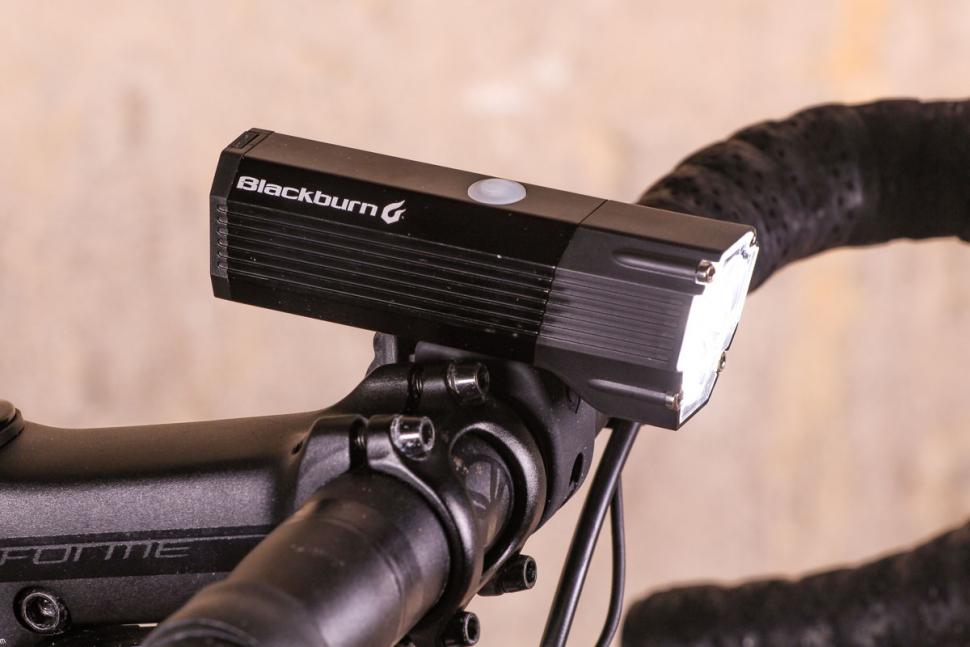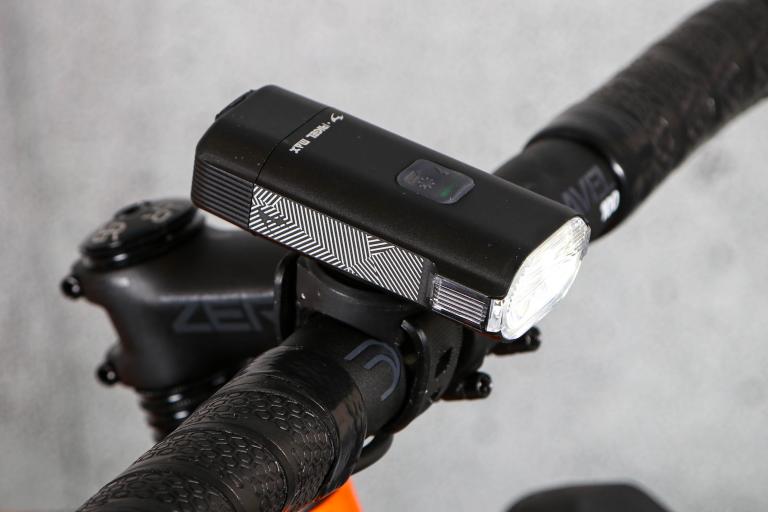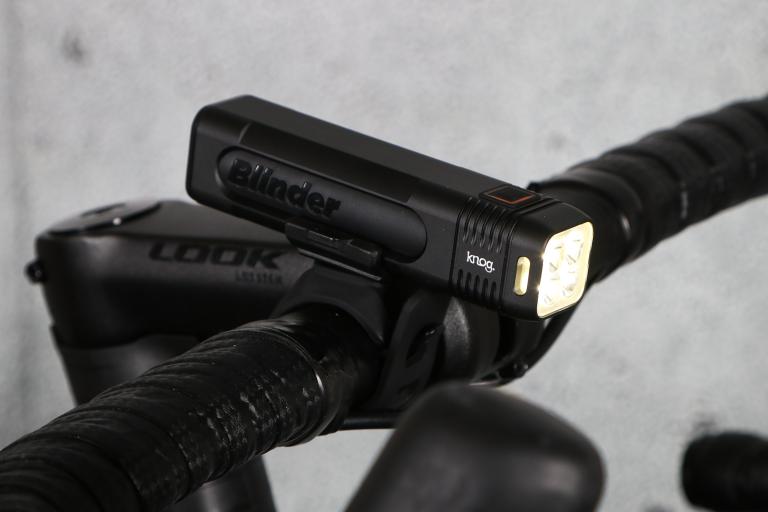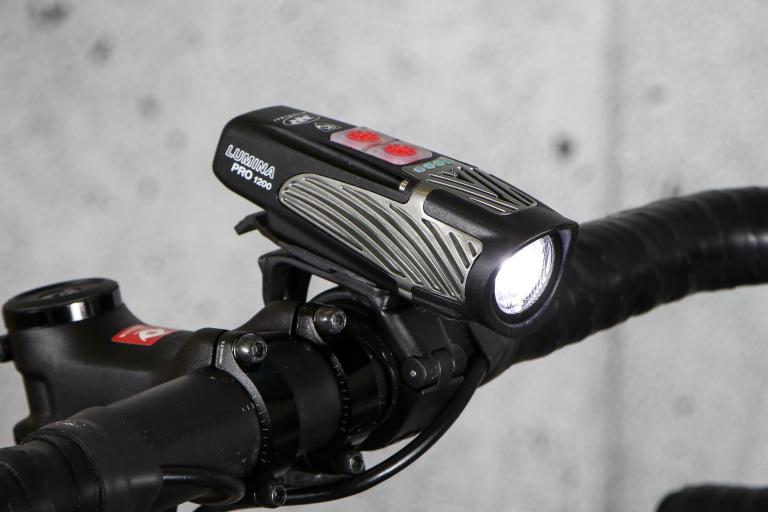- News
- Reviews
- Bikes
- Components
- Bar tape & grips
- Bottom brackets
- Brake & gear cables
- Brake & STI levers
- Brake pads & spares
- Brakes
- Cassettes & freewheels
- Chains
- Chainsets & chainrings
- Derailleurs - front
- Derailleurs - rear
- Forks
- Gear levers & shifters
- Groupsets
- Handlebars & extensions
- Headsets
- Hubs
- Inner tubes
- Pedals
- Quick releases & skewers
- Saddles
- Seatposts
- Stems
- Wheels
- Tyres
- Tubeless valves
- Accessories
- Accessories - misc
- Computer mounts
- Bags
- Bar ends
- Bike bags & cases
- Bottle cages
- Bottles
- Cameras
- Car racks
- Child seats
- Computers
- Glasses
- GPS units
- Helmets
- Lights - front
- Lights - rear
- Lights - sets
- Locks
- Mirrors
- Mudguards
- Racks
- Pumps & CO2 inflators
- Puncture kits
- Reflectives
- Smart watches
- Stands and racks
- Trailers
- Clothing
- Health, fitness and nutrition
- Tools and workshop
- Miscellaneous
- Buyers Guides
- Features
- Forum
- Recommends
- Podcast
review
 Blackburn DayBlazer 1100 Front
Blackburn DayBlazer 1100 Front£84.99
VERDICT:
Versatile and very well made, with sensible settings, though emergency kickdown would be welcomed
Weight:
142g
Contact:
At road.cc every product is thoroughly tested for as long as it takes to get a proper insight into how well it works. Our reviewers are experienced cyclists that we trust to be objective. While we strive to ensure that opinions expressed are backed up by facts, reviews are by their nature an informed opinion, not a definitive verdict. We don't intentionally try to break anything (except locks) but we do try to look for weak points in any design. The overall score is not just an average of the other scores: it reflects both a product's function and value – with value determined by how a product compares with items of similar spec, quality, and price.
What the road.cc scores meanGood scores are more common than bad, because fortunately good products are more common than bad.
- Exceptional
- Excellent
- Very Good
- Good
- Quite good
- Average
- Not so good
- Poor
- Bad
- Appalling
The Blackburn Dayblazer 1100 front light is the biggest of the Dayblazer family. It's a beautifully made, five-function, compact torch type, capable of producing – surprise, surprise – 1100 lumens in its brightest setting, great for blasting along backroads, but with lower settings, pulsing and strobing for more built-up areas and for daylight running.
- Pros: Great build quality, lovely design, sensible settings
- Cons: No auto kickdown when reserves dwindle
Blackburn has an envious reputation for build quality and the Dayblazer 1100 is no exception. It's a surprisingly slender design, consuming very little bar space. The shell and cowling are beautifully made from CNC machined 6061 aluminium which, aside from looking gorgeous, affords excellent heat dispersal and defence against everyday carelessness. Used for prolonged periods and with a cooling breeze, the light never became uncomfortable to touch.
> Find your nearest dealer here
It meets ANSI (American National Standards Institute) FL1 for weather repellence, output and operating times, and IP67 for weather-proofing and withstanding being dropped onto a hard surface from a metre.
It's never missed a beat either in heavy rain or when subjected to my garden-hose torture test. The charge port covers fit snugly, so I can't see any issues on this front, while a limited lifetime warranty offers further peace of mind.
Modes
'Blitz' is the most potent of the steady options (1100 lumens), followed by medium (800) and low (400 lumens). Finally, we have pulsing and strobe, both 200 lumens apiece.
Moving between them requires a definite press of the large, rubberised switch, though it's still easy to operate in gloved hands. A memory function helpfully defaults to your last selection, and subsequent presses cruise through the other settings. A two-second press brings it to life/power down.
The switch has an integrated 'traffic light' style battery-life indicator and the lithium-ion battery is replaceable. This ensures the unit doesn't become bin fodder when the factory unit dies and, theoretically, also means spares can be carried and swapped over, extending ride times.
Output
The sophisticated TIR lens and 'double decker' Cree diodes project a seamless combination of flood and very pure spot beams, and the side windows are sensibly proportioned.
For fast-paced efforts along the backroads, 1100 lumens is my yardstick. With the Dayblazer 1100 I could blast along at 28mph with ample warning of upcoming holes, ruts and similar hazards.
The beam pattern's purity is excellent without being anti-social. Aside from the odd SUV, oncoming vehicles dipped their beams at around 100m. Bar-mounted, there's been no call for me to reciprocate, but helmet-mounted, although 1100 was useful along some faster trails, exceeding 800 is borderline anti-social even along unlit roads.
In these settings, the wide arc of light probably had greater effect upon peripheral prowess than the side windows. Either way, I nailed driver attention when passing unlit, concealed junctions.
At the full 1100, reserves hit amber given 45 minutes, and slip into red just past the hour. Like most decent lights these days, there's no dimming/similar deterioration and the red holds out for a further 20 minutes, then once it starts pulsing you've 10 minutes before being plunged into darkness. I would have liked a limp-home kick-down, say to flashing once reserves had hit 10%.
The medium 800 lumens copes very well in semi-rural contexts and to around a steady 23mph, faster through partially lit sections. Other traffic registered me at 50-60m, so there's plenty of presence.
Run-times are pretty accurate for the 1100 and 800 settings: 90 minutes and 2 hours, respectively.
Adequate for semi-rural navigation to around 17mph, 400 lumens is a little overpowered for suburban antics per se. That said, it's not overkill either and I was glad of the additional presence when going under bridges and other secluded stretches.
Run-times aren't far behind the Xeccon Spear 900 – just under three hours, from a full charge.
Pulsing is quite distinctive, being just quick enough to attract attention but pure enough to tackle most built-up areas. Performance is excellent around dusk, with other traffic picking me out at 70m or so. In this setting it's returned 6hrs 53mins (7 minutes off those cited): enough for a week's middle-distance commuting between charges.
Strobing's pace is perfect for being seen, particularly around dusk, but there's plenty of punch during the day too. It's not quite on par with something like Moon's Meteor Storm Pro or Cateye's Volt 1700 but is visible at 70m, maybe 150 on a very clear night, 90 round town, and it'll go nigh-on 12 hours from a full charge.
Charging
Speaking of which... charging is via the ubiquitous micro-USB plug, which is super-convenient. Bargain on the full five hours cited, although I've managed 4hrs 35mins using a more powerful cable, feeding from the mains supply.
Mounting bracket
There are two mounting options: the more traditional watch strap type, with a swivel design, making fitment and removal a two-second cinch. This gives reliable tenure across the full cornucopia of bar diameters from 25.4 to 31.8mm. Alternatively, there's an action cam affair, for helmet mounting.
As with anything cited 'Universal' it's begging for contradiction, but ours has fitted limpet-like to my eclectic collection of road/trail/commuting/touring models.
Conclusion
The Dayblazer 1100's five settings cover most bases and, with intelligent use, offer reasonable economy.
Though not the most obvious choice, it's proven a useful companion to a high-power dynamo, adding a bit more presence in the strobing and pulsing settings, with the blitz and medium coming into their own when I suffered a short. However, I was disappointed by the lack of auto kickdown – it's not something you'd expect to need very often but it's commonly found and on cheaper models.
Verdict
Versatile and very well made, with sensible settings, though emergency kickdown would be welcomed
road.cc test report
Make and model: Blackburn DayBlazer 1100
Size tested: The action-style camera mount fits virtually any bar size (from 25.4-35mm) as well as many helmets.
Tell us what the light is for, and who it's aimed at. What do the manufacturers say about it? How does that compare to your own feelings about it?
Blackburn says, "This little devil packs a 1100 lumen punch onto a tiny bar perch. Weighing in at just 140 grams, this light hits way above its weight class. Want to hit the local trail for a midnight shred, or commute home on a November evening? The sleek and tiny DayBlazer 1100 has you covered. Featuring our eye catching BLITZ daytime running mode to grab the attention of cars, an action-style camera mount, ample side visibility and IP-67 submerse-ability, the DAYBLAZER 1100 is your new best riding buddy."
My feelings are that it's a competent and versatile light with some very usable settings. However, though accurate, run-times in the highest settings are relatively short. An automatic "kickdown" function would be welcomed, too.
Tell us some more about the technical aspects of the light?
Blackburn lists these features:
* Meets ANSI FL-1 Standard
This standard was created by the American National Standards Institute (ANSI) to provide consistent performance measurements for handheld lights. Although bicycle lights are not required to follow this or any standard, Blackburn believes in offering full transparency in how the output, run time, water resistance and other performance claims are measured.
*
Excellent Side Visibility
Built in design features channel a bright hit of light to each side providing visibility to cross traffic.
*
LED Fuel Gauge/Charge Indicator
A small built in LED light indicates the battery level. Green = >75%, Orange = 75-25%, Red = <25%
*
Replaceable Battery
Battery pack can be replaced in seconds.
Tool free install
Lithium-ion battery
Waterproof to IP-67 standard
5 hour recharge time
Dual Beam Pattern
Separate action camera mount included
LED Charge Indicator
Runtime: BLITZ 1.5hrs (1100 lumen), Medium 2hrs (800 lumen), Low 3 hrs (400 lumen)
Runtime: Pulse/Strobe: 7hrs (200 lumen)/12 hrs (200 lumen)
140g
Rate the light for quality of construction:
8/10
Well made, especially by price point standards.
Rate the light for design and ease of use. How simple was the light to use?
8/10
Very user-friendly, even in full finger gloves.
Rate the light for the design and usability of the clamping system/s
7/10
Simple and reliable. GoPro-style helmet option is a definite plus.
Rate the light for waterproofing. How did it stand up to the elements?
9/10
Has passed my hosepipe torture tests and everyday rainfall with flying colours.
Rate the light for battery life. How long did it last? How long did it take to recharge?
6/10
Average overall and typical of this genre.
Rate the light for performance:
8/10
Excellent, high quality output.
Rate the light for durability:
9/10
Should last and Blackburn's warranty adds confidence.
Rate the light for weight:
8/10
Rate the light for value:
8/10
Represents very good value for money, relative to specification and competitor designs.
Tell us how the light performed overall when used for its designed purpose
It's very good both in the navigational and seen-by senses, from backroads to town centre, day or night, thanks to the clever hybrid beam and decent quality optics. An emergency "kickdown" SOS/flashing setting would be welcomed.
Tell us what you particularly liked about the light
Build and optical quality, coupled with decent run-times in the lower settings.
Tell us what you particularly disliked about the light
An auto kickdown "limp home" mode, when battery reserves tumble, would be welcomed.
How does the price compare to that of similar products in the market, including ones recently tested on road.cc?
Pricing seems very competitive relative to the specification. Its 800-lumen sibling might prove better value, for those who don't need the additional firepower. Riders wanting to do longer runs along the darkest roads are better served by units with similar clout but fuelled by external battery packs.
Did you enjoy using the light? Yes
Would you consider buying the light? Possibly
Would you recommend the light to a friend? Yes if they were seeking a versatile, torch type model.
Use this box to explain your overall score
Overall a decent lamp with great output and moderate price tag, best suited to those who want versatility but aren't doing long runs along unlit roads or are happy to recharge frequently.
About the tester
Age: 44
I usually ride: Rough Stuff Tourer Based around 4130 Univega mtb Frameset My best bike is: 1955 Holdsworth Road Path and several others including cross & traditional road
I've been riding for: Over 20 years I ride: Most days I would class myself as: Experienced
I regularly do the following types of riding: cyclo-cross, commuting, touring, fixed/singlespeed, mountain biking
Shaun Audane is a freelance writer/product tester with over twenty-eight years riding experience, the last twelve (120,000 miles) spent putting bikes and kit through their paces for a variety of publications. Previous generations of his family worked at manufacturing's sharp end, thus Shaun can weld, has a sound understanding of frame building practice and a preference for steel or titanium framesets.
Citing Richard Ballantine and an Au pair as his earliest cycling influences, he is presently writing a cycling book with particular focus upon women, families and disabled audiences (Having been a registered care manager and coached children at Herne Hill Velodrome in earlier careers)
Latest Comments
- E6toSE3 19 min 34 sec ago
April Fool or not, age 70 with infant grandchildren to push around SE London and a wife who has limited mobility due to hit by motorbike, I'm in...
- David9694 41 min 21 sec ago
Calls for Oxfordshire transport chief to resign blocked...
- Mr Blackbird 1 hour 35 sec ago
Depends how you ride them. The current trend among many pros is to ride in a track style looking down at the front wheel. Ok for racing on closed...
- Oldfatgit 3 hours 4 min ago
Are these actually 'hi-viz' - or just brights?...
- Bungle_52 3 hours 5 min ago
That one was completely different though, it was a driver not a car as in the other 3. So 1 in 4 of the stories manage to follow reporting guidelines.
- Rendel Harris 4 hours 58 min ago
Absolutely they could have. Tarmac is a petroleum-based product and its surface can be very oily when it's newly laid. This is particularly the...
- ROOTminus1 11 hours 19 sec ago
I'm glad the article went into more detail and cleared things up, the headline had me worried that some autonomous building had run rampant and...
- mark1a 11 hours 18 min ago
Still here, just showing a few signs of wear and tear. Hopefully still serviceable for some years to come.
- Rendel Harris 12 hours 3 min ago
How can you know that you are "equally fearful" as "any female cyclist"? There is no possible way of quantifying such emotions and female cyclists...
- chrisonabike 12 hours 35 min ago
I think it would be fairer to blame the moon - as in "my client is a loony".




Add new comment
10 comments
What a terrible light! Exactly as MRMOLE says - it kicks down to lowest setting after cca 3 minutes of usage when temperature outside was around 20 degrees C. Also, the battery capacity is terrible - wanted to check it at 1100 lumens, but it always kicked down to 400, so I tested at least that setting and it barely survived 2 hours, just terrible terrible. Other than that - battery is not really replaceable, at least I couldn't figure out how, wit cateye volt 800 it was pretty straightforward. Also - the strap is attached to light by scrre so everytime you want to charge the battery you have to remove the whole light, what a poor design. Last and least important - vast majority of micro USB cables doesn't fit because the connector is hidden too deep. Very disappointed..
Review says there is a replaceable battery - how do I replace it? Cant find instructions for it in any review, nor in the user manual that was attached to my light.. Thanks for help
Cant find instructions for it in any review, nor in the user manual that was attached to my light.. Thanks for help
Pretty disappointed with this light overall! Sure my lux readings closely match the road.cc results but only at startup with a full charge and output degrades very rapidly after that. I also find myself at odds with the road test as the 2 examples I have of this light I will step down to the lowest mode within the first 3 min. of operation when run in the blitz mode from what I'm assuming is the automatic thermal protection. Light itself doesn't seem to get that warm but the entire back of the light is just a cover with only one small attachment point so isolated from thermal path leaving relative small heat-sink surface area/mass. 800 lumen med. mode doesn't fare much better. No overheating and output starts out strong but rapidly degrading output leaves the light operating at less than 500 lumens for most of the med. modes runtime. So wow, not sure why my 2 Dayblazer 1100's (one was a replacement from Blackburn) perform so differently from the one road.cc has but thought my experience was worth mentioning. One star would be my rating for this light.
Typical BehindTheBikeSheds argument:
1: this is shit.
2: the one I have is much better.
Sometimes he is probably right, but like the boy who cried wolf........
I did enjoy the IMHO.
There is nothing 'humble' about his opinions.
Blackburn (and Giro, Bell, CamelBak, Bolle and Bushnell) are owned by assault weapons firm Vista Outdoor. Make your own (informed) choices and enjoy your next ride.
Thank you lots for the information. I was about to buy the Blackburn Countdown 1600. To th ehell with Blackburn: I'm not going to pay inbred tigger-happy animal-abusing hicks a dime for anything. Having a Garmin device is bad enough. This - is perfectly intolerable.
A good hunter is the dead one.
too hard to come up with some actual photos of the beam in use?
A 200lumen strobe is a piss take, any light with that brightness on that setting is crap and IMHO dangerous, it doesn't have to be anywhere near that, anything over 100lumen is pointless but causes issues that light makers just simply ignore as well as reviewers.
£85 these days is excessive for such a basic light with realtively short runs times, this is a far better light reviewed here last year for a few quid more https://road.cc/content/review/221409-ravemen-pr1200-usb-rechargeable-du...
we're putting the beam engine together this week, so we'll add the it to this review probably on monday.
The spot beam and pulsing mode are both described as “pure” and the beam patterns “purity is excellent”. What does that mean? What is a “pure” beam?